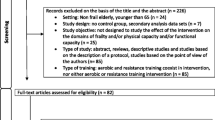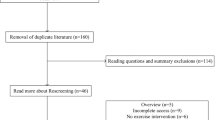Abstract
Background
Due to the worldwide demographic transition healthcare systems are facing new demands and are increasingly confronted with an older population with specific medical needs related to multiple chronic disorders. The majority of older persons have an increased risk of frailty. In addition to pharmaceutical interventions another beneficial approach for counteracting frailty might be exercise or physical activity intervention.
Objective
The first goal was to narratively investigate the state of the art effective exercise interventions for frail older persons and briefly discuss the importance of exercise intervention for frailty. The second goal was to give recommendations to overcome barriers in the recruitment process and how to increase adherence of frail older persons in exercise programs.
Results
Several systematic reviews came to the same conclusion that exercise has beneficial effects in frail older persons although uncertainty exists on the optimal exercise program with regard to frequency, type of exercise and duration. Furthermore, all reviews demonstrated the superior nature of multicomponent exercise programs as opposed to single component exercise programs. With regard to barriers different levels have to be taken into account and addressed: older persons themselves with self-efficacy and attitudes, the healthcare personnel involved and the provider of the intervention program.
Conclusion
Exercise seems a promising approach to counteract frailty but including frail older persons in research programs is challenging. Researchers have to be aware of the different levels of possible barriers ranging from older frail persons and medical personnel to researchers.
Zusammenfassung
Hintergrund
Bedingt durch den demographischen Wandel steigt der Anteil älterer Menschen mit Komorbiditäten deutlich an. Insbesondere der eindimensionale Ansatz des Gesundheitswesens, sich auf isolierte Erkrankungen zu fokussieren, wird dem multiplen Erkrankungsspektrum des älteren, oft fragilen Menschen nicht gerecht. Übergreifende Interventionsansätze wie körperliche Aktivität und Training, die auf die überwiegende Anzahl von Erkrankungen und Risikofaktoren des alten, fragilen Menschen eine positive Wirkung ausüben, können hier eine Lösung darstellen.
Ziele
Als erstes Ziel wird im Rahmen einer narrativen Übersicht der Stellenwert effektiver Trainingsinterventionen im Spannungsfeld „Frailty“ kurz dargestellt und damit die Bedeutung von Trainingsprogrammen hervorgehoben. Als zweites Ziel werden Handlungsempfehlungen bei der Rekrutierung von komorbiden älteren Menschen gegeben, basierend auf bekannten Barrieren und eigenen Erfahrungen aus entsprechenden Forschungsprojekten. Hierbei liegt der Fokus auf der Rekrutierung älterer Menschen mit funktionellen Einschränkungen in die angebotenen Bewegungsprogramme und der anschließenden Adhärenz zum Training.
Ergebnisse
Die Mehrzahl der vorliegenden Untersuchungen im Fachbereich kommen übereinstimmend zu dem Ergebnis, dass multivariates körperliches Training zumeist positive Effekte auf die Mehrzahl der Frailty-Kompenenten ausübt, wenngleich die optimale Komposition der Belastungskomponenten und -inhalte bislang nicht identifiziert werden konnte. Mit Blick auf Limitationen und Fallgruben von Trainingsinterventionen sind mögliche Fehlerquellen auf unterschiedlichen Ebenen und seitens verschiedener Akteure zu finden.
Schlussfolgerung
Körperliches Training ist grundsätzlich ein vielversprechender Ansatz um den Frailty-Prozess zu modifizieren. Trainingsinterventionen sind jedoch sehr komplexe Prozesse, die mit besonderen Herausforderungen verbunden sind und oft schwieriger und zeitintensiver als erwartet verlaufen. Forscher sollten daher bereits im Vorfeld der Untersuchung mögliche Schwierigkeiten und Besonderheiten auf allen relevanten studienbeteiligten Ebenen antizipieren und einplanen.
Similar content being viewed by others
References
Turner G, Clegg A (2014) Best practice guidelines for the management of frailty: a British Geriatrics Society, Age UK and Royal College of General Practitioners report. Age Ageing 43(6):744–747
Cesari M (2011) The multidimensionality of frailty: Many faces of one single dice. J Nutr Health Aging 15(8):663–664
Cesari M, Canevelli M (2014) Horse-racing effect and clinical trials in older persons. Front Aging Neurosci 6:175
Clegg A, Young J, Iliffe S, Rikkert MO, Rockwood K (2013) Frailty in elderly people. Lancet 381(9868):752–762
Gill TM, Gahbauer EA, Allore HG, Han L (2006) Transitions between frailty states among community-living older persons. Arch Intern Med 166(4):418–423
Gobbens RJ, Luijkx KG, Wijnen-Sponselee MT, Schols JM (2010) Towards an integral conceptual model of frailty. J Nutr Health Aging 14(3):175–181
Buta BJ, Walston JD, Godino JG, Park M, Kalyani RR, Xue QL et al (2016) Frailty assessment instruments: Systematic characterization of the uses and contexts of highly-cited instruments. Ageing Res Rev 26:53–61
Abellan van Kan G, Rolland Y, Bergman H, Morley JE, Kritchevsky SB, Vellas B (2008) The I.A.N.A Task Force on frailty assessment of older people in clinical practice. J Nutr Health Aging 12(1):29–37
Caspersen CJ, Powell K, Christenson GM (1985) Physical activity, exercise, and physical fitness: Definitions and distinctions of health-related research. Public Health Rep 100(2):126–131
Montero-Fernandez N, Serra-Rexach JA (2013) Role of exercise on sarcopenia in the elderly. Eur J Phys Rehabil Med 49(1):131–143
Goisser S, Kemmler W, Porzel S, Volkert D, Sieber CC, Bollheimer LC et al (2015) Sarcopenic obesity and complex interventions with nutrition and exercise in community-dwelling older persons – a narrative review. Clin Interv Aging 10:1267–1282
Chodzko-Zajko WJ, Proctor DN, Fiatarone Singh MA, Minson CT, Nigg CR, Salem GJ et al (2009) American College of Sports Medicine position stand. Exercise and physical activity for older adults. Med Sci Sports Exerc 41(7):1510–1530
Tudor-Locke C, Craig C, Aoyagi Y, Bell R, Croteau K, De Bourdeaudhuij I et al (2011) How many steps/day are enough? For older adults and special populations. Int J Behav Nutr Phys Act 8(1):80
Chin A, Paw MJM, van Uffelen JGZ, Riphagen I, van Mechelen W (2008) The functional effects of physical exercise training in frail older people: A systematic review. Sports Med 38(9):781–793
Daniels R, van Rossum E, de Witte L, Kempen G, van den Heuvel W (2008) Interventions to prevent disability in frail community-dwelling elderly: a systematic review. BMC Health Serv Res 8(1):278
Theou O, Stathokostas L, Roland KP, Jakobi JM, Patterson C, Vandervoort AA et al (2011) The effectiveness of exercise interventions for the management of frailty: a systematic review. J Aging Res 2011:1–19. doi:10.4061/2011/569194
Cadore EL, Rodriguez-Manas L, Sinclair A, Izquierdo M (2013) Effects of different exercise interventions on risk of falls, gait ability, and balance in physically frail older adults: a systematic review. Rejuvenation Res 16(2):105–114
de Vries NM, van Ravensberg CD, Hobbelen JSM, Olde Rikkert MGM, Staal JB, Nijhuis-van der Sanden MWG (2012) Effects of physical exercise therapy on mobility, physical functioning, physical activity and quality of life in community-dwelling older adults with impaired mobility, physical disability and/or multi-morbidity: A meta-analysis. Ageing Res Rev 11(1):136–149
Giné-Garriga M, Roqué-Fíguls M, Coll-Planas L, Sitjà-Rabert M, Salvà A (2014) Physical exercise interventions for improving performance-based measures of physical function in community-dwelling, frail older adults: A systematic review and meta-analysis. Arch Phys Med Rehabil 95(4):753–769
de Labra C, Guimaraes-Pinheiro C, Maseda A, Lorenzo T, Millan-Calenti JC (2015) Effects of physical exercise interventions in frail older adults: a systematic review of randomized controlled trials. BMC Geriatr 15:154
Chou C‑H, Hwang C‑L, Wu Y‑T (2012) Effect of exercise on physical function, daily living activities, and quality of life in the frail older adults: A meta-analysis. Arch Phys Med Rehabil 93(2):237–244
Pedersen BK, Saltin B (2015) Exercise as medicine – evidence for prescribing exercise as therapy in 26 different chronic diseases. Scand J Med Sci Sports 25(Suppl 3):1–72
Harris R, Dyson E (2001) Recruitment of frail older people to research: lessons learnt through experience. J Adv Nurs 36(5):643–651
Knechel NA (2013) The challenges of enrolling older adults into intervention studies. Yale J Biol Med 86(1):41–47
Ridda I, Lindley R, MacIntyre RC (2008) The challenges of clinical trials in the exclusion zone: The case of the frail elderly. Australas J Ageing 27(2):61–66
Ross S, Grant A, Counsell C, Gillespie W, Russell I, Prescott R (1999) Barriers to participation in randomised controlled trials: A systematic review. J Clin Epidemiol 52(12):1143–1156
Campbell MK, Snowdon C, Francis D, Elbourne D, McDonald AM, Knight R et al (2007) Recruitment to randomised trials: strategies for trial enrollment and participation study. The STEPS study. Health Technol Assess 11(48):iii–105
Ridda I, MacIntyre CR, Lindley RI, Tan TC (2010) Difficulties in recruiting older people in clinical trials: an examination of barriers and solutions. Vaccine 28(4):901–906
Yardley L, Beyer N, Hauer K, McKee K, Ballinger C, Todd C (2007) 2007 Recommendations for promoting the engagement of older people in activities to prevent falls. Qual Saf Health Care 16(3):230–234
Yardley L, Donovan-Hall M, Francis K, Todd C (2007) Attitudes and beliefs that predict older people’s intention to undertake strength and balance training. J Gerontol B Psychol Sci Soc Sci 62(2):P119–P125
Hawley-Hague H, Horne M, Campbell M, Demack S, Skelton DA, Todd C (2014) Multiple levels of influence on older adults’ attendance and adherence to community exercise classes. Gerontologist 54(4):599–610
Freiberger E, Vreede P (2011) Falls recall-limitations of the most used inclusion criteria. Eur Rev Aging Phys Act 8(7):105–108
Kemmler W, von Stengel S, Weineck J, Lauber D, Kalender W, Engelke K (2005) Exercise effects on menopausal risk factors of early postmenopausal women: 3‑yr Erlangen fitness osteoporosis prevention study results. Med Sci Sports Exerc 37(2):194–203
Provencher V, Mortenson WB, Tanguay-Garneau L, Belanger K, Dagenais M (2014) Challenges and strategies pertaining to recruitment and retention of frail elderly in research studies: a systematic review. Arch Gerontol Geriatr 59(1):18–24
Tinetti E, Powell L (1993) Fear of falling and self-efficacy: a cause of dependence in elderly persons. J Gerontol 48(special):35–38
Rochat S, Bula CJ, Martin E, Seematter-Bagnoud L, Karmaniola A, Aminian K et al (2010) What is the relationship between fear of falling and gait in well-functioning older persons aged 65 to 70 years? Arch Phys Med Rehabil 91(6):879–884
Malini FM, Lourenco RA, Lopes CS (2016) Prevalence of fear of falling in older adults, and its associations with clinical, functional and psychosocial factors: The Frailty in Brazilian Older People-Rio de Janeiro Study. Geriatr Gerontol Int 16(3):336–344
Freiberger E, Blank WA, Salb J, Geilhof B, Hentschke C, Landendoerfer P, Halle M, Siegrist M (2013) Physiological and psychological effects of a multi-modal intervention on fall risk: A cluster randomized controlled trial in the general practitioner setting [PreFalls NCT01032252]. Clin Interv Aging 8:1079–1108
Phillips EM, Katula J, Miller ME, Walkup MP, Brach JS, King AC et al (2010) Interruption of physical activity because of illness in the Lifestyle Interventions and Independence for Elders Pilot trial. J Aging Phys Act 18(1):61–74
Bleijenberg N, Ten Dam VH, Steunenberg B, Drubbel I, Numans ME, De Wit NJ et al (2013) Exploring the expectations, needs and experiences of general practitioners and nurses towards a proactive and structured care programme for frail older patients: a mixed-methods study. J Adv Nurs 69(10):2262–2273
Drey M, Zech A, Freiberger E, Bertsch T, Uter W, Sieber CC et al (2011) Effects of strength training versus power training on physical performance in prefrail community-dwelling older adults. Gerontology 58(3):197–204
Drey M, Pfeifer K, Sieber CC, Bauer JM (2011) The Fried frailty criteria as inclusion criteria for a randomized controlled trial: personal experience and literature review. Gerontology 57(1):11–18
Kemmler W, von Stengel S, Engelke K, Sieber C, Freiberger E (2016) Prevalence of sarcopenic obesity in Germany using established definitions: Baseline data of the FORMOsA study. Osteoporos Int 27(1):275–281
Hawley-Hague H, Horne M, Skelton DA, Todd C (2016) Older adults’ uptake and adherence to exercise classes: instructors’ perspectives. J Aging Phys Act 24(1):119–128
Borg GA (1982) Psychophysical bases of perceived exertion. Med Sci Sports Exerc 14(5):377–381
Author information
Authors and Affiliations
Corresponding author
Ethics declarations
Conflict of interests
E. Freiberger, W. Kemmler, M. Siegrist and C. Sieber declare that they have no conflict of interests.
All studies on humans described in the present manuscript were carried out with the approval of the responsible ethics committee and in accordance with national law and the Helsinki Declaration of 1975 (in its current, revised form). Informed consent was obtained from all patients included in studies.
Rights and permissions
About this article
Cite this article
Freiberger, E., Kemmler, W., Siegrist, M. et al. Frailty and exercise interventions. Z Gerontol Geriat 49, 606–611 (2016). https://doi.org/10.1007/s00391-016-1134-x
Received:
Revised:
Accepted:
Published:
Issue Date:
DOI: https://doi.org/10.1007/s00391-016-1134-x




